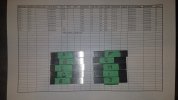hugofeynman
Gold Member
- Joined
- Jan 18, 2011
- Messages
- 837
Great news! Let’s throw some bainite to those charpy tests! Results will be really interesting, to say the least! It would be great to test 1095, 5160 and 52100 to full lower bainitic transformation and, of course, L6.@Stacy E. Apelt - Bladesmith is working on some salt pot samples from a salt pot that @mete donated. We should get some interesting results from that.
Never heard of PM steels heat treated to bainite. Would it, in theory, be possible and reach a useable hardness or RA would be too high to even try?

